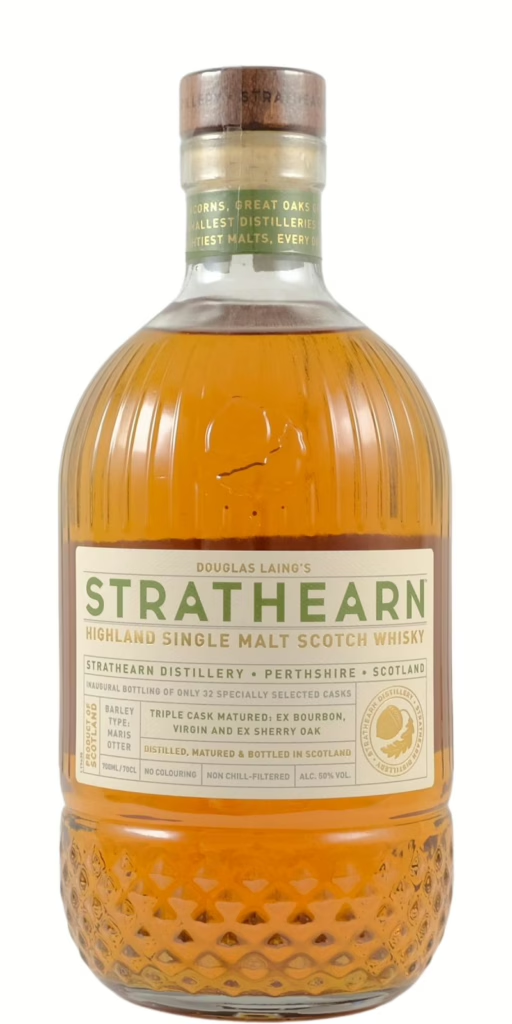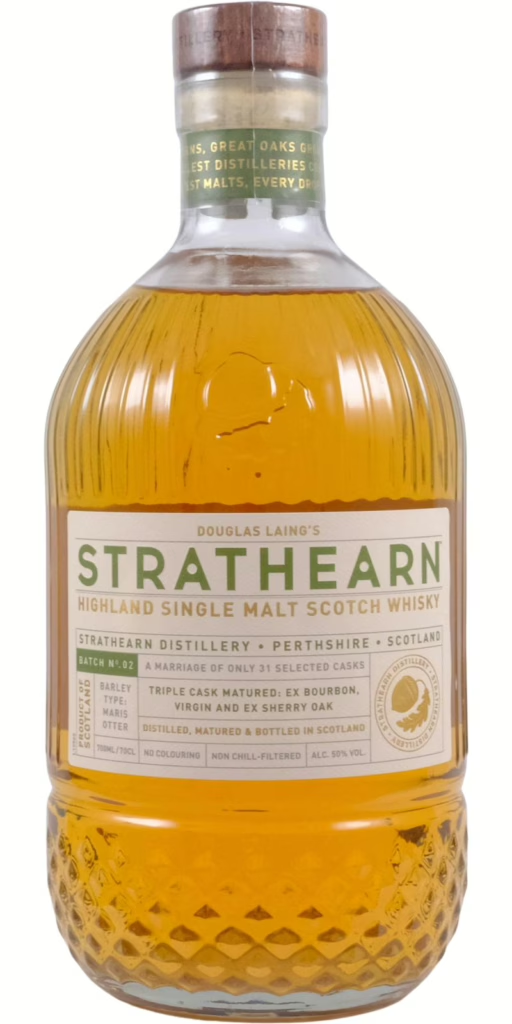Strathearn Distillery is a small-batch single malt Scotch whisky producer located near Methven in Highland Perthshire, Scotland. Founded in 2013 by Tony Reeman-Clark and partners, the distillery operates within a historic 160-year-old stone farm steading, on the site of an earlier 18th-century distillery. Known as probably Scotland’s smallest distillery, Strathearn is distinguished by its artisanal approach, using Maris Otter Malt, small 50-litre casks (at least during the initial ownership) and a notably long fermentation time of up to 144 hours, which contributes to its uniquely fruity character. In 2019, the distillery was acquired by Douglas Laing & Co, a Glasgow-based independent bottler, which expanded its production capacity and launched new expressions such as “The Heart” in 2022. Strathearn manually handles every step from malt preparation to distillation, employing alembic-style stills imported from Portugal. We review the Strathearn Inaugural Bottling and Single Malt Batch No. 02.
Strathearn Inaugural Bottling (2024) Review
Strathearn released its second Inaugural Bottling in 2024, but the first since Douglas Laing took over, as there was a first Inaugural bottling back in 2016, when Strathearn was still under its original management. This new inaugural is combining contents from 32 ex-Bourbon, Virgin oak, and ex-Sherry oak casks. They inherited some of these casks when Douglas Laing acquired the Strathearn Distillery, along with a portion of spirit distilled under Douglas Laing’s ownership. They then reduced this inaugural bottling to 50% ABV and bottled it without chill filtration or added colouring. The initial recommended retail price stood at £85, and it is still widely available, with some UK shops offering it for as low as £70, and in Europe for around €90-€100.

Colour:
Deep copper.
Nose:
Neat: The nose presents a malty character and feels spirit-driven, despite the inclusion of sherry and virgin casks alongside bourbon ones. It offers a farm-like quality, with notes of malt, reminiscent of a grain barn and draff post-mashing. Fruity aromas of peaches in syrup, apricots, apples, and plum eau de vie are also present. Additionally, there is a hint of spice, including dried berries and various spices, along with some sharpness from, I guess, the virgin oak.
With water: The aroma shifts slightly more towards apples, but the overall nose becomes somewhat blurred, making it harder to distinguish individual scents. There is a bit more wood influence, though it feels less sharp.
Palate:
Neat: The palate begins with a warm, citrusy tartness and a syrupy mouthfeel. There is a slight bitterness from oak, along with notes of chocolate, grapefruit, and cereals. Buttery nuances, molasses, a hint of pickled ginger, and oak spices are also noticeable.
With water: The palate turns sweeter, with flavours of raspberries and cherries emerging before the citrusy tartness returns. There is a bit more bitterness from the wood, accompanied by spices and a hint of smoke.
Finish:
The finish is relatively short, featuring notes of pear, apple, molasses, and spices.
Comments:
The Strathearn Inaugural Bottling presents itself as a good and straightforward young single malt. It avoids the pitfall of overly active wood influence (or worse, STR or wine casks), with the virgin oak contributing only subtly to the overall profile. While it exhibits potential, it could benefit from additional maturation to soften its rough edges. Although it may seem a bit pricey, this release stands as a promising first official single malt from this emerging Highland distillery.
Rating: 6/10
Strathearn Single Malt Batch No. 02 (2025) Review
The Strathearn Single Malt Batch No. 02 builds on the foundation of the Inaugural Bottling, maintaining the triple cask maturation process that includes ex-bourbon, virgin oak, and ex-sherry casks. However, this edition places a greater emphasis on the influence of bourbon casks and reduces the proportion of virgin oak casks. Similar to the Inaugural, they bottled this edition at 50% ABV without chill filtration or added colouring. It is available for approximately £80 in the UK and €80 in Europe.

Colour:
Old old.
Nose:
Neat: The nose closely resembles that of the Inaugural Bottling but feels slightly drier and sharper. It presents notes of malt, wood sawdust, and spices such as cinnamon and pepper, along with curry-flavoured cashew nuts. Hints of pears and apples emerge, though it is considerably less fruity than the Inaugural Bottling.
With water: The aroma primarily features cereals, accompanied by a touch of honey.
Palate:
Neat: The palate bursts with flavours of apples, pear, and wood spices. Malt makes another appearance, alongside rye bread, dark chocolate, and black cherries, with a noticeable wood bitterness. Hints of fennel and menthol, along with herbal liqueur, suggest this batch 2 is slightly younger than the Inaugural Bottling.
With water: Apples dominate again, accompanied by various grains and rye bread, with a hint of gentian.
Finish:
The finish is medium long, warm, on dark chocolate, ginger bread, pepper and grapefruit bitterness.
Comments:
This expression is quite enjoyable, yet I find myself favoring the Inaugural Bottling. Despite the increased use of ex-bourbon casks and a reduction in virgin oak casks, this version comes across as slightly sharper on the nose and younger on the palate. This leads me to speculate whether the average age of the spirits in this second batch might be lower than that of the Inaugural Bottling.
Nevertheless, it certainly merits more than a 5 or 5.5 out of 10, so I would rate it a 6. Ultimately, the preference between the two may come down to individual taste. In my view, it could also benefit from a few additional years of maturation to further refine its character.
Rating: 6/10
Bottle pictures courtesy of Whiskybase. Small edit regarding to the Inaugural Bottling to precise that there was an first one during original management (thanks Mark!)